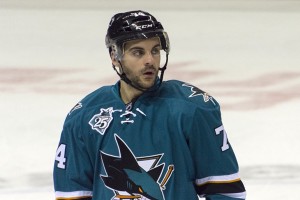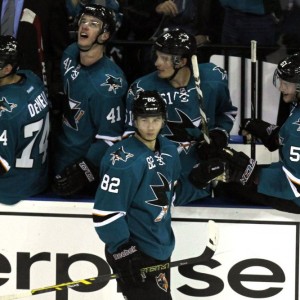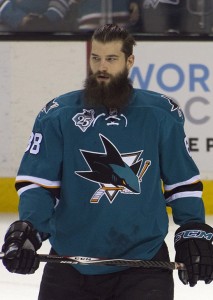My last article began with an observation. The Sharks had used just 19 skaters, with 17 skaters playing every game. Another game into the season, 11 in total, and the skater tally remains the same. Aside from the choice between Micheal Haley and Matt Nieto as the twelfth forward, the Sharks’ skating lineup has remained unchanged. Even the goaltender has been the same for 10 of the 11 games played.

This sameness in the lineup works against the longer term needs of the team. The Sharks have several potential NHL players on their AHL team, the San Jose Barracuda. They have Dylan DeMelo, currently with the Sharks, playing no games at all. Backup goaltender Aaron Dell made his NHL debut back on October 18, winning his lone NHL start while playing effectively. He has not played since.
In Goal
Martin Jones played 89 games last season. The last goalie to hit 90 was Martin Brodeur, over a decade ago. Jones is again being worked heavily, while Dell is not getting the chance to establish himself as a reliable backup. It is quite challenging for a goalie to play at a high level when given multiple weeks off between games. The Sharks need to know what they have in Dell, for better or worse. It would be wise for the team to give Dell a chance to put his best skate forward, which means giving him frequent work early in the season.
Up Front

Meanwhile, the San Jose Barracuda of the AHL are off to a respectable start. Two wins in four games, with one of the losses coming in a shootout. The Barracuda have an open question on the blue line and in goal. However, the forward depth is as good as it’s been in a very long time for a Sharks minor league team.
Two forwards, Kevin Labanc and Nikolay Goldobin, have seven points in just four games. Ryan Carpenter was tabbed to join the Sharks for their five-game round trip but did not play. Barclay Goodrow was an AHL All-Star last season and had played respectably for the Sharks in prior seasons. Marcus Sorenson, a veteran of the top Swedish league, is also in the mix as he adapts to the smaller North American ice surface.
Early in the season is an opportune time to get younger players a taste of the NHL. It provides several benefits for both the player and organization. Most importantly, it lets the big club know if the player is ready to make the leap to the NHL, and if not, where the main deficiencies lie. By ‘experimenting’ early in the season with roster changes, there is a greater chance to capture value later in the season.
Ice Time Considerations
Among the bigger challenges the Sharks will have this season is to keep their veterans healthy while avoiding excessive wear and tear. The key players in this are Joe Thornton (age 37), Joe Pavelski (age 32, with very physical minutes for a smaller player) and to a lesser extent, Paul Martin (age 35).
Thornton’s ice time is actually slightly ahead of last season, Pavelski’s slightly less. Prior to the start of the season, both the coach and general manager suggested the veterans’ ice time would need to be carefully managed. So far, it is essentially the same as last season for the two Joes. Martin’s ice time, though, has dropped nearly two minutes a game. His play is a bit sluggish and his effectiveness is cause for modest concern.
http://gty.im/491368476
Using the same lineup has benefits, one would expect a fast start, especially with so many key players returning. And while the Sharks are off to a reasonable start, a 6-5 record is not exactly leaving other teams in the dust.
A Long Season
San Jose can do more to help the long-term prospects of this team. Providing NHL stints to some of the talented young forwards on the AHL roster is one step. Getting Dylan DeMelo playing time while giving Paul Martin a game off here and there is another. Martin Jones is playing three games a week while Aaron Dell is getting one game every three weeks. Shifting to a more balanced goaltending schedule would benefit both players.
In the playoffs last year, the Sharks used 19 skaters with Martin Jones dominating the time in goal, starting every game and finishing all but one. Sameness can be a big advantage in the playoffs. The regular season requires different considerations.
Ultimately, most teams rely on far more than 19 skaters and one goalie to get through an 82 game regular season. It is in the Sharks’ best interest to find out what they have beyond their core group.
Zeke’s Notes

Brent Burns turned his defensive game around in the second half of last season. Early this season, there has been some regression. In the recent loss to Calgary, the game-winning goal came when Burns abandoned his man to double team a Flame player. The player he left uncovered, Matthew Tkachuk, went unchallenged to the front of the net and scored. We’ve seen this movie before.
At this time last season, there was little indication or evidence suggesting Burns could turn his defensive game around. This season is different. The second half of last season proves Burns can play a strong defensive game. I expect his recent defensive regression to end, and soon. After all, last year’s movie did have a happy ending.
Sharks general manager Doug Wilson was inducted into the San Jose Sports Hall of Fame earlier this week . Wilson, the Sharks’ first team captain, is just the third player to be honored with an induction. Wilson’s tenure as part of San Jose’s management has had more impact than his two seasons playing for the Sharks.
Worth noting, Wilson played during the seasons when the Sharks played their home games in San Francisco, not in San Jose. Wilson retired prior to the opening of the Shark Tank.
Goalie Arturs Irbe was the first Sharks player inducted (2010), Owen Nolan the second (2014). The Sharks’ original owner, the late George Gund, was the first member of the Sharks organization to receive the honor (2008). It is fair to say many current and recent Sharks players are likely to receive this honor in the years ahead.